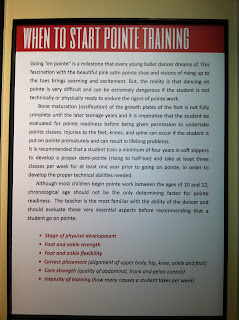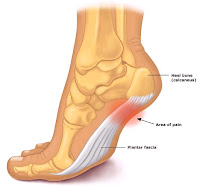Several students asked for even more information regarding
injuries common in dancers. According to Fitt, many dance injuries happen because of
misalignments and the compensations that occur. This leads to a chain reaction and thus, we have an injury. Here are some of her highlights that we'll start with today:
1. Pronation (rolling in) of the tarsus
· Affects the weight-bearing patterns of the foot
· Affects the alignment of the knee and hip, possibly the spine
· Causes a shift of weight to the medial side of the foot – bunions can form
· Ankle sprains possible
· Pressure added on knee which could result in knee injuries
· Hips can inwardly rotate while leads to contracted outward rotators – can cause spasm in deep rotators and lead to sciatic syndrome
2. Variance in leg length
· Pelvis will tip to one side and the torso will shift (laterally) toward side of long leg in order to maintain a vertical posture
· Will lead to scoliosis – will curve to the side of the long leg
· Could also maintain slight hip flexion on side of longer leg leading to tight hip flexors and the twist of the pelvis – imbalance of strength and elasticity of right and left flexors and extensors
· Difficulty in balance work and movement
3. Tight hip flexors (and chain reactions)
· With increased amounts of sitting we have tight hip flexors and hip remains in flexed position when standing
· Front spine of pelvis is pulled downward which causes swayback
· Hyperextension of the lumbar spine allows extensors to tighter and leads to low back pain and spasm
· Will affect remaining spine
· Dancer will compensate by gripping gluteus maximus muscles, extensors of the hip
· Will cause knee to flex and the extensors of the knee (quadriceps) will grip causing “thunder thighs” and “bubble butts”
· Can lead to hyperextended knees
What to do? Depending upon what your personal compensation is you can...
Stretch the hip flexors (2, 3)
Foam roll the calf muscle (1)
Foam roll the I-T band (1, 2, 3)
Foam roll quads (3)
Foam roll glutes (2, 3)
Strengthen the hamstrings (2, 3)
Strenghten the glutes (2)
Strengthen the abductors (outside of thigh) (1)
Strengthen core muscles for pelvic stability and mobility (2)
Balance training (1, 2)
When completing our pre-assessments during the first week of the NYSSSA program, we looked for some of these issues as well as others. Many of these are out of our control (skeletal/structural issues) and the key is knowing about your body so you can be prepared while preventing these injuries.
Look for more specific injuries tomorrow!


















